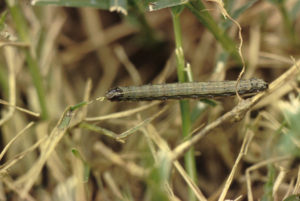School Gardens
 As August approaches and teachers come back from summer break, the neglected gardens might need some attention and maintenance in preparation for fall planting. If the area is over grown and herbicides need to be applied, remember that you will need time between making the application and planting. More importantly under the School IPM rules, you will need to post the area and keep students out of the area for at least 4 hours.
As August approaches and teachers come back from summer break, the neglected gardens might need some attention and maintenance in preparation for fall planting. If the area is over grown and herbicides need to be applied, remember that you will need time between making the application and planting. More importantly under the School IPM rules, you will need to post the area and keep students out of the area for at least 4 hours.
If the gardens plants have been damaged from heat or bugs, it’s important to dispose of them immediately. While heat-damaged plants can be added to compost piles, bug or disease-damaged plants should be pulled from the ground, wrapped in plastic, and disposed of separately to avoid transferring the problem to other plants. This is especially true if some of your garden plants are rose bushes. Rose rosette disease has recently begun to make resurgence. Botanists have identified the pathogen that infects rose bushes and that it is spread by a tiny, wingless mite. The mites feed on a plant’s sap, transmitting the virus to the bush. Roses die within two to three years. The best solution that has been recommended so far is the removal and complete destruction of an infected rose plant. I can personally attest that once you have it the best thing to do is remove the infected plants.
Planting fall foods, remember the mulch, mulch is your friend. Use generous amounts to insulate your fall starters., but also help keep those tender roots cool during the warm days. Make sure you mulch isn’t too ‘new’, one of the most common mistakes people do with home made compost is placing ‘hot compost’ on the garden plants. Make sure your compost is on the cool down process so that it doesn’t leach nutrients from the plants.
Pot herbs, rather than planting them into the ground. Herbs can survive the winter comfortably from an indoor environment or with greenhouse or in some locations with row covers. When putting your garden to bed for the winter, pot your herb plants. Place these pots in a sunny, warm window location and consider this an alternative to keep herbs alive all year round. In Texas our weather can turn soon and suddenly. While you don’t want your herb plants to experience a freeze, it’s more than okay to keep the potted plants outside until the first frost. This gives them every possible opportunity for direct sunlight and fresh air prior to moving indoors for winter. You may want to think about a location at the campus where you would want to transition potted plants. Moving plants from outdoors to indoors can also mean bringing in some other invaders like cockroaches, ants, spiders, or other unwanted visitors who can hid in potted plants. Be sure to remind teachers and staff about this tip so that you don’t inadvertently bring a pest problem indoors.
Finally, if you have not visited the USDA Community Food Systems web site, I recommend you do! I was recently asked if there were any guidelines on location of school gardens, how can you work with other programs like National School Lunch Program. Everything you need to know about community gardens can be found here. Using Gardens to Grow Healthy Habits in Cafeterias, Classrooms, and Communities is a great fact sheet for school administrators and IPM Coordinators to review and plan for having a garden now and in the future.
Scouting for turf pests
During the summer Texas Turfgrass Association meeting I heard Dr. Matt Elmore and Dr. Casey Reynolds talk about herbicides and turf pests. Some of the turf pests they were discussing have some interest to those of you who manage athletic fields but also open areas.
Fall armyworms are on the move! The armyworm moth flies and mates at night, they migrate like other caterpillar type species. What typically gives most athletic directors heartburn is when you see a mass of caterpillars covering their turf. Check out this fact sheet from Dr. Reynolds Armyworm gives you good information about this pest and what to do.
Mole crickets if you live in the piney woods of east Texas this pest could be coming to a field near you. Mole crickets tend to spend their time underground but adults have wings and disperse in the breeding season. They mainly feed on roots, but can also each grubs as well. The Aggieturf website has another good fact sheet on this pest.
With all the wet weather we have had this year, you will want to think about getting your Green Category fire ant baits out this August. Insect growth regulator bait needs time to get out, be picked up by the ants, and taken back into the colony. There are many options for managing various kinds of fire ant problems. When using pesticides, use only products labeled for the location or “site” you want to treat. For instance, DO NOT use a product in your vegetable garden unless that site is listed on the label. Many combinations of control options are available, and there may be no single best method. Fire Ants and the Texas IPM in Schools Program is a comprehensive document outlining a solid fire ant management program for all school settings.



 .
.